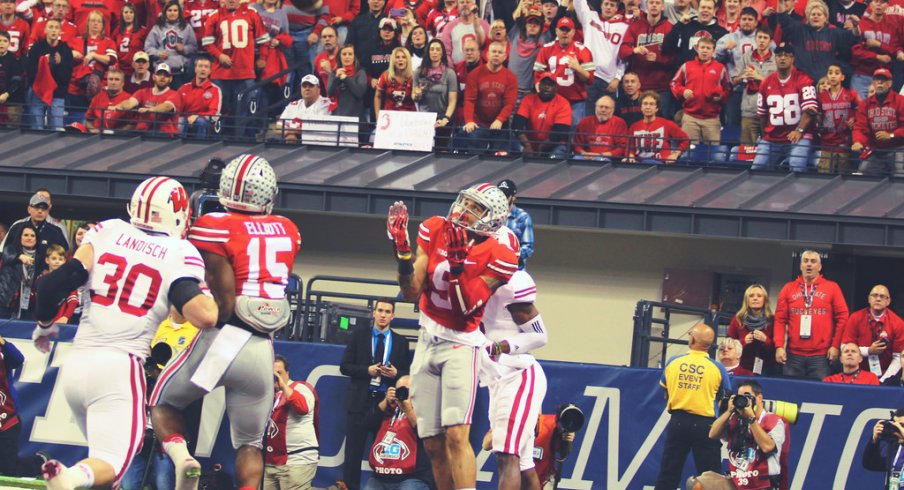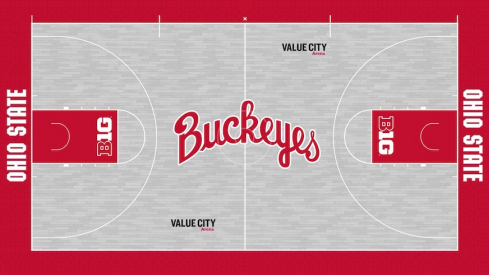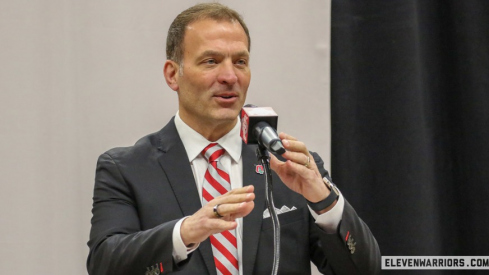It's no secret you need speed as a wide receiver to put yourself in position to take the top off a defense down the field, but there are many other qualities that translate to being a successful deep threat.
"It's a number of things," Ohio State wide receivers coach Zach Smith said April 20. "It's being able to defeat a press corner or an off corner on a deep rout. Obviously, the speed it takes to separate from the corner, obviously the corners we play against can run well. And then tracking the deep ball is not easy, especially running at that speed."
Body control plays a huge part when the football is in the air, because what separates a good player from a great one in that part of their game is if they can reel in the pass and stay on their feet.
“That's something that a guy like Devin comes around and you think 'Oh, he's open, touchdown,' and you move on. You don't know how hard that was, so it's a combination of a lot of things, but the combination of being great at all those things is pretty rare.”– Zach Smith
Ohio State's passing game severely missed wide receiver Devin Smith last season. Urban Meyer called Smith "the best deep ball catcher in America" on more than one occasion during his senior season in 2014, when Smith nearly hit the 1,000-yard receiving mark with only 33 receptions.
Think about that. Smith was 69 yards away from 1,000 receiving yards and didn't even have 35 catches. The 28.2 yards per catch average was the best in the country by more than four yards.
"That's something that a guy like Devin comes around and you think 'Oh, he's open, touchdown,' and you move on," Zach Smith said. "You don't know how hard that was, so it's a combination of a lot of things, but the combination of being great at all those things is pretty rare."
Devin Smith made it look easy during Ohio State's national championship season, hauling in 12 touchdown passes — four in the postseason.
Smith had 11 receptions that went for more than 40 yards in 2014. Ohio State's wide receivers combined for just seven such receptions last year.
"It's a big issue every spring, but obviously when you lose a kid like Devin and you don't match the production the next year, it's always going to be an issue until you have a guy who is a dynamic deep threat," Zach Smith said.
Devin Smith is in a class of his own, but it's not like Ohio State doesn't have speed to burn at receiver. The names we wrote and read about this spring — Terry McLaurin, Torrance Gibson, Johnnie Dixon, James Clark, Parris Campbell and Austin Mack — took steps in their development because they were healthy (or healthier than they have been). They are also four or five-star recruits, depending where you look.
Curtis Samuel, Dontre Wilson, Noah Brown and Corey Smith sat out the majority or all of spring drills with various injuries. Brown was expected to be a big piece in the 2015 offense, but we are still unsure what he can do downfield due to the broken leg he suffered in August.
The ongoing quarterback dilemma between J.T. Barrett and Cardale Jones didn't help Ohio State's passing game last season, but neither did the inconsistencies at receiver. Braxton Miller was barely six months into his transition from quarterback. Jalin Marshall played H-back in 2014 but moved to the outside last fall. Samuel played running back his freshman year.
"You have great athletes but there are so many things they have to learn, the tricks of their trade, to become really good," quarterbacks coach Tim Beck said. "The passing game is based on spacing and timing. If you have guys who aren't sure or they're not the right depth or the quarterback has to move around a little bit, sometimes that creates timing issues. Maybe there was some of that last year."
Beck is pleased with what he saw from the candidates at wide receiver to replace those who are onto the NFL. Meyer is too, provided everyone stays healthy, since they have another year of development under their belts. Dixon's ailing knees were a particularly hot topic this spring because his stellar speed allows him to have deep threat potential, provided he can stay on the field.
"If he can help us be a vertical receiver because he’s legitimately fast, then we’re going to be good," Meyer said of Dixon March 8, the first day of spring practice.
He knows how vital it is to have a downfield threat like Devin Smith. It opens up everything else on the offense, particularly play-action passes. No one on the current roster is expected to be Devin Smith, but there are more than enough worthy candidates.
"There's really a handful of them," Zach Smith said. "Terry McLaurin had a great spring as far as deep ball percentage. James Clark, Johnnie Dixon, Curtis Samuel when healthy can do it certainly, Parris Campbell, those are guys who have the skill set. It's just a matter who is the most dynamic I guess."


